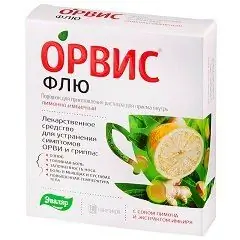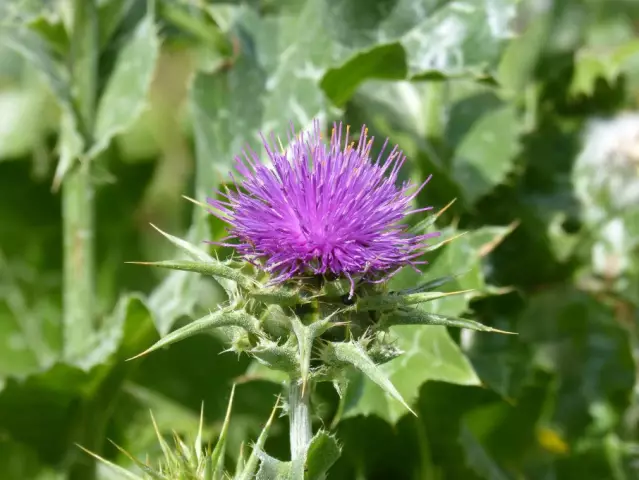- Author Rachel Wainwright [email protected].
- Public 2023-12-15 07:39.
- Last modified 2025-11-02 20:14.
Orvis Flew
Orvis Flew: instructions for use and reviews
- 1. Release form and composition
- 2. Pharmacological properties
- 3. Indications for use
- 4. Contraindications
- 5. Method of application and dosage
- 6. Side effects
- 7. Overdose
- 8. Special instructions
- 9. Application during pregnancy and lactation
- 10. Use in childhood
- 11. In case of impaired renal function
- 12. For violations of liver function
- 13. Use in the elderly
- 14. Drug interactions
- 15. Analogs
- 16. Terms and conditions of storage
- 17. Terms of dispensing from pharmacies
- 18. Reviews
- 19. Price in pharmacies
Latin name: Orvis Flu
ATX code: N02BE51
Active ingredient: ascorbic acid (Ascorbic acid), paracetamol (Paracetamol), pheniramine (Pheniramine)
Manufacturer: CJSC "Evalar" (Russia)
Description and photo update: 2019-08-07
Prices in pharmacies: from 149 rubles.
Buy

Orvis Flew Evalar is a symptomatic remedy for the treatment of acute respiratory diseases.
Release form and composition
Dosage form - powder for the preparation of a solution for oral administration (lemon-ginger): granular, may contain easily crumbling lumps, from light pink with a yellowish tinge to light brown (inclusions of brown, gray and white are possible), with a characteristic odor lemon and ginger; the prepared solution is cloudy, light yellow with a brownish or pinkish tinge, with a characteristic smell of lemon and ginger, may contain undissolved particles from yellowish to brown (4.95 g in sachets, in a cardboard box 4, 6, 10 or 20 sachets and instructions for the use of Orvis Fly).
Orvis Flew composition for 1 sachet:
- active substances: paracetamol - 500 mg, ascorbic acid - 200 mg, pheniramine maleate - 25 mg;
- auxiliary components: dry ginger extract (ginger root extract, maltodextrin, starch, colloidal silicon dioxide), powdered lemon concentrate (lemon juice, citric acid, maltodextrin), natural flavoring "Lemon" (natural aromatic component, aromatic composition, gum arabic), maltodextrin, citric acid anhydrous, aspartame, maltodextrin, sodium citrate.
Pharmacological properties
Pharmacodynamics
Orvis Flew is a combined agent, the action of which is due to the properties of its active ingredients:
- paracetamol is a non-narcotic analgesic that affects the centers of thermoregulation and pain by blocking cyclooxygenase (mainly in the central nervous system), as a result of which it has an antipyretic and analgesic effect;
- ascorbic acid (vitamin C) - participates in blood clotting, regulation of carbohydrate metabolism and redox processes, the synthesis of steroid hormones and tissue regeneration. Reduces vascular permeability, the need for pantothenic and folic acids, vitamins A, B 1, B 2 and E. Prolongs the action of paracetamol and improves its tolerance;
- pheniramine is a blocker of H 1 -histamine receptors. Eliminates spastic phenomena, hyperemia and swelling of the mucous membrane of the nasal cavity, nasopharynx and paranasal sinuses, reduces rhinorrhea and lacrimation.
Pharmacokinetics
Paracetamol after oral administration is rapidly absorbed from the gastrointestinal tract. The maximum plasma concentration reaches within 10-60 minutes. It is quickly distributed throughout the tissues of the body, penetrates the blood-brain barrier. It binds to plasma proteins insignificantly, which has no therapeutic value, however, as the dose is increased, the connection increases. It is metabolized in the liver: about 80% of the dose received is conjugated with sulfates and glucuronic acid to form inactive metabolites, 17% of the dose undergoes a hydroxylation reaction with the formation of 8 active metabolites, which are subsequently conjugated with glutathione, as a result of which inactive metabolites are formed. One of the hydroxylated metabolic intermediates exhibits hepatotoxic activity. It is rendered harmless by conjugation with glutathione, however, it can accumulate in the body and in case of an overdose (150 mg of paracetamol / kg of body weight or 10,000 mg of paracetamol orally) cause necrosis of hepatocytes. The drug is excreted by the kidneys mainly in the form of metabolites (most of them are conjugates), no more than 5% of paracetamol is excreted unchanged. Half-life (T½) is 1-3 hours.
Ascorbic acid, entering the digestive tract, is absorbed in the small intestine. The maximum plasma concentration reaches within 4 hours. Bioavailability is about 70%. It is metabolized in the liver. It is excreted in the form of metabolites and unchanged by the kidneys, through the intestines and with sweat.
Pheniramine is almost completely absorbed in the gastrointestinal tract. T ½ is 1-1.5 hours. It is excreted mainly by the kidneys.
Indications for use
Orvis Flew is used to eliminate and relieve symptoms such as chills, fever, headache, sneezing, lacrimation, rhinorrhea, nasal congestion, muscle and joint pain, with the following diseases:
- nasopharyngitis;
- acute respiratory diseases;
- acute respiratory viral infections;
- flu.
Contraindications
Absolute:
- portal hypertension;
- liver failure;
- erosive and ulcerative lesions of the gastrointestinal tract in the acute phase;
- alcoholism;
- urinary retention associated with diseases of the prostate gland and urinary disorders;
- angle-closure glaucoma;
- deficiency of the enzyme glucose-6-phosphate dehydrogenase;
- phenylketonuria;
- age up to 15 years;
- period of pregnancy and lactation;
- known hypersensitivity to any component in Orvis Flew.
Relative (Orvis Flew should be used with caution, after consulting a doctor):
- renal failure [creatinine clearance (CC) <10 ml / min];
- viral hepatitis;
- alcoholic hepatitis;
- congenital hyperbilirubinemia (Rotor, Gilbert and Dubin-Johnson syndromes);
- recurrent formation of urate kidney stones;
- Chronical bronchitis;
- bronchial asthma;
- simultaneous use of drugs with a potentially hepatotoxic effect;
- combined use of tricyclic antidepressants;
- joint or previous 2 weeks use of monoamine oxidase inhibitors (MAO);
- elderly age.
Orvis Flew, instructions for use: method and dosage
Orvis Flu powder is taken orally, after dissolving the contents of the package in 200 ml of hot water (50-60 º), adding sugar if necessary. You can choose any time of day, however, it is considered more preferable to take the drug before bedtime, at night, in which case the greatest effect is noted.
Adults are prescribed 1 sachet 2-3 times a day. The highest permissible dose of Orvis Flu for patients weighing more than 50 kg is 8 sachets per day. However, the interval between doses should not be less than 4 hours, with severe renal dysfunction (CC <10 ml / min) - 8 hours.
The maximum duration of admission is 5 days. If symptom relief is not observed, fever persists or rises again after initial decrease, a doctor should be consulted.
Side effects
When used in the recommended doses, Orvis Flu is well tolerated. In some cases, the following side effects are noted:
- from the digestive system: dryness of the oral mucosa, abdominal pain, nausea, vomiting, constipation, nephrotoxicity, hepatotoxic effect;
- from the nervous system: drowsiness, tremors, impaired coordination, dizziness, insomnia, nervousness, agitation, hallucinations, confusion, impaired concentration (more often in elderly patients);
- on the part of the organ of vision: violation of accommodation, mydriasis;
- from the cardiovascular system: palpitations, orthostatic hypotension;
- from the hematopoietic system: anemia, leukopenia, thrombocytopenia, agranulocytosis;
- from the genitourinary system: violation of urination;
- from the respiratory system: bronchospasm;
- from the immune system: acute generalized exanthematous pustulosis, toxic epidermal necrolysis (Lyell's syndrome), Stevens-Johnson syndrome;
- allergic reactions: skin rash, urticaria, itching, erythema, anaphylactic shock, Quincke's edema.
Overdose
Symptoms of acute paracetamol poisoning: epigastric pain, nausea, vomiting, anorexia, drowsiness, pallor of the skin, increased sweating, metabolic acidosis (including lactic acidosis). The overdose threshold can be lowered in children, the elderly, malnourished patients, and patients who consume alcohol and take certain medications (for example, inducers of liver microsomal enzymes). After 1-2 days, signs of a functional liver disorder appear. In severe cases, liver failure, hepatonecrosis, encephalopathy, coma are possible - complications fraught with death.
Symptoms of feniramine poisoning: impaired consciousness, convulsions, coma.
In case of taking an excessive dose of Orvis Flu, you should rinse your stomach, take enterosorbents (activated carbon, hydrolytic lignin) and consult a doctor. As an antidote, acetylcysteine is administered intravenously or administered orally (if possible, in the first 10 hours after an overdose), further treatment is symptomatic.
special instructions
Orvis Flu powder does not contain sugar, therefore it can be prescribed for patients with diabetes mellitus.
During the period of treatment, if possible, the use of other paracetamol-containing drugs should be avoided. In the case of taking such a combination, it should be borne in mind that the total daily dose of paracetamol in all taken means should not exceed 4000 mg, otherwise an overdose may develop.
To avoid toxic damage, you should refrain from drinking alcohol.
Orvis Flew is not recommended for patients with alcohol abuse. People with alcoholic hepatitis have an increased risk of liver damage.
In the case of prolonged use of Orvis Flew and / or in high doses, mental dependence on the drug may develop.
Influence on the ability to drive vehicles and complex mechanisms
In some patients, Orvis Flew causes drowsiness and dizziness, in this regard, it is recommended to refrain from performing work that requires precise reactions and increased attention.
Application during pregnancy and lactation
Animal studies have not been conducted; there is no clinical experience with the combination of paracetamol + ascorbic acid + pheniramine during pregnancy. For this reason, Orvis Flew is contraindicated in pregnant women.
It is not known whether the active substances of Orvis Flew penetrate into the mother's milk. If treatment is required during lactation, women are advised to stop breastfeeding.
Pediatric use
Orvis Flew is not prescribed for children and adolescents under 15 years of age.
With impaired renal function
In severe renal failure (CC <10 ml / min), drug treatment should be carried out with caution.
For violations of liver function
Liver failure is a contraindication to the appointment of Orvis Flew.
Use in the elderly
Elderly patients should be treated with caution.
Drug interactions
Pheniramine enhances the effect of the following drugs: sedatives from the H 1 group of histamine blockers, antidepressants (amitriptyline, mianserin, mirtazapine), antipsychotics (meprobamate, phenothiazine derivatives), morphine derivatives, barbiturates, benzodiazepine derivatives and other central tranquilizers, hypotensive drugs … When using such a combination, the sedative effect increases, the likelihood of side effects such as dryness of the oral mucosa, urinary retention, and constipation increases.
Ethanol enhances the sedative effect of pheniramine, contributes to the development of acute pancreatitis.
Paracetamol increases the effect of indirect anticoagulants. Reduces the effect of uricosuric drugs.
The hepatotoxic effect of paracetamol is enhanced by inducers of microsomal oxidation: ethanol, rifampicin, phenylbutazone, flumecinol, tricyclic antidepressants, barbiturates, anticonvulsants (phenytoin).
With the simultaneous use of salicylates, they increase the risk of developing nephrotoxic effects, glucocorticosteroids - the risk of developing glaucoma.
Orvis Flew enhances the toxicity of chloramphenicol (chloramphenicol).
It is possible to enhance the central atropine-like effects with the combined use of other drugs with anticholinergic properties, such as antipsychotics of the phenothiazine series, antidepressants of the imipramine group, atropine-like antispasmodics, m-anticholinergic antiparkinsonian drugs, other antihistamines, disopyramide.
Analogs
Orvis Flew analogs are: AjiCOLD, Antigrippin, Antigrippin-Express, Antiflu, Aspirin Complex, Vicks Active Symptomax, Vicks AntiFlu Complex, Gripex, Grippostad C, Influblock, Caffetin Cold, Coldrex, Coldfree, Maxi-flucindald, Pentaudaldan Teraflu, Fastorik, Febriset, Fervex, Flustop, etc.
Terms and conditions of storage
Store at a temperature not exceeding 25 ºС out of reach of children.
The shelf life is 3 years.
Terms of dispensing from pharmacies
Available without a prescription.
Reviews about Orvis Flew
Patients leave positive feedback about Orvis Flew: the drug quickly and effectively eliminates the symptoms of a cold, reduces fever, and normalizes the general condition. It is also well-tolerated and relatively inexpensive.
The hot drink tastes good overall, but some people dislike the ginger flavor.
The price of Orvis Flew in pharmacies
The average price for Orvis Fleu Evalar for a pack of 10 sachets is 221 rubles.
Orvis Flew: prices in online pharmacies
|
Drug name Price Pharmacy |
|
ORVIS Flu 500 mg + 25 mg + 200 mg powder for preparation of oral solution lemon-ginger 4.95 g 4 pcs. 149 r Buy |
|
Orvis flu powder for prig solution for internal approx. lemon and ginger pack. 4.95g 10 pcs. 182 r Buy |
|
Orvis Flu 500 mg + 25 mg + 200 mg powder for preparation of oral solution lemon-ginger 4.95 g 10 pcs. 182 r Buy |

Anna Kozlova Medical journalist About the author
Education: Rostov State Medical University, specialty "General Medicine".
Information about the drug is generalized, provided for informational purposes only and does not replace the official instructions. Self-medication is hazardous to health!






